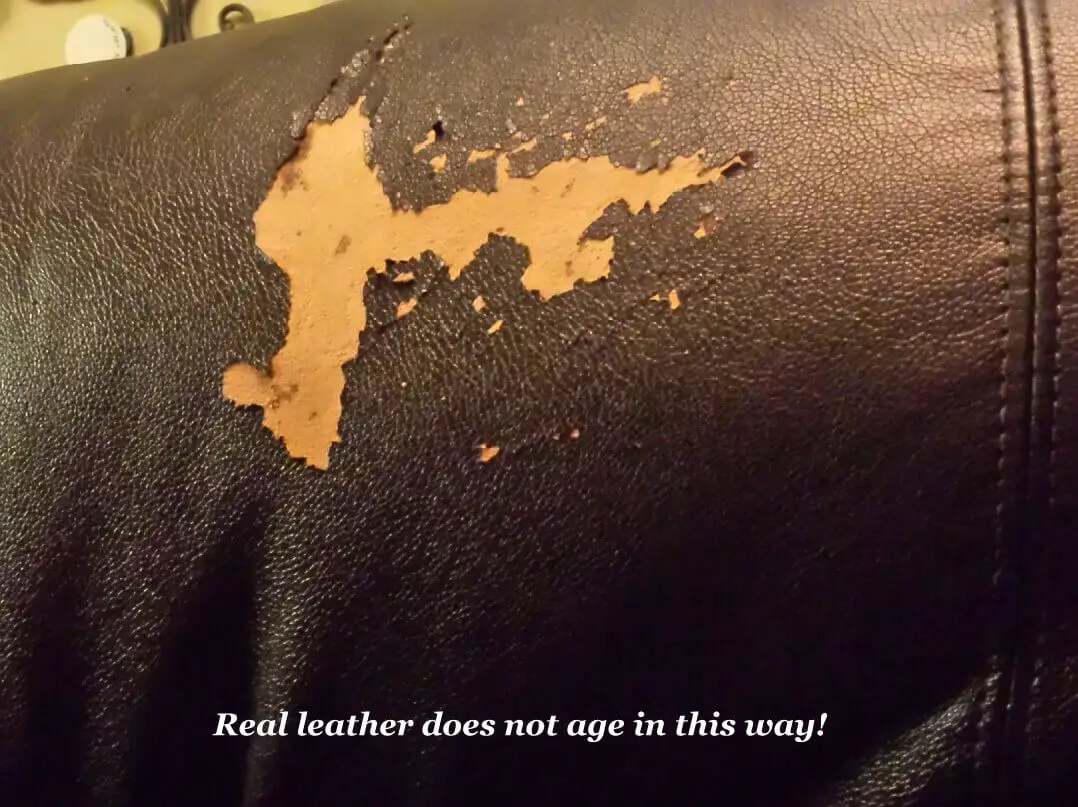Which synthetic faux leather is the most durable?
I’m looking at different types of synthetic faux leathers and vegan leathers.
What’s the difference and which will last longer?
I had a faux leather sofa that started flaking off after 4 years. I’m not sure what the makeup of it was, but I don’t want this to happen again.
Answer:
If your faux leather started flaking off, it was bonded leather.
Hundreds of thousands of complaints about peeling or flaking have been registered since bonded leather was first introduced in 2010.
Many of these complaints are from shoppers who thought they had purchased durable genuine leather furniture.
Lots of other shoppers are afraid that all faux leathers are subject to peeling and flaking. That is not the case!
100% synthetic faux leathers, including those made with vinyl, polyurethane, polyester, silicon, and plant-based materials, are extremely durable and completely stable.
They do not peel or flake!
Furniture sellers have finally realized many of their customers actively avoid furniture made with bonded leather.
Over the past few years, low cost composite faux leathers, made with combinations of polyester and polyurethane, have been replacing bonded leather.
These newer polyester/polyurethane composite materials look and feel very similar to bonded leathers. Most people can’t tell the difference in looks or feel.
The newer composites have now been in widespread use in residential seating for about 5 years.
Bonded leather is still widely used for low cost imported office seating.
So far, the new composite synthetics appear to be just as stable as vinyls, polyurethanes, and other 100% synthetic faux leathers that have been available for decades.
Vegan leathers are quickly becoming more popular.
At first, the term “Vegan leather” referred to a small number of plant based synthetic leathers.
More recently, there seems to be an industry-wide trend to label all faux and synthetic leathers as “Vegan leather.”
Bonded leathers were first introduced because of a huge demand for cheaper leather furniture.
In 2010, furniture manufacturers and retailers were just beginning to recover from a major Recession that devastated the furniture industry over the previous 3 years.
During that period, 40% of U.S. furniture manufacturers and 20% of retailers closed their doors.
Although leather furniture was very popular for those who could afford it, most shoppers could not.
Up until 2010, furniture shoppers overwhelmingly refused to accept existing 100% synthetic faux leathers as a lower cost substitute for genuine leather.

Bonded leather worked because salespeople could promote it as “partially real leather.”
They strongly implied that this made it almost as good as genuine leather from hides, and superior to 100% synthetic faux leathers.
After a dozen years of bonded leather’s well-publicized problems, shoppers have finally accepted 100% synthetic faux, synthetic, and vegan leathers as acceptable low-cost leather substitutes.
This is a major change in public perception since 2010, when bonded leather was first introduced.
Another factor in replacing bonded leather was the development of new composite faux leathers that combined polyester and polyurethane.
The new composite faux leathers were indistinguishable from bonded leather to most furniture shoppers.
They were also far more durable. Many were less expensive.
New low-cost polyester based faux leathers are now available.
Until the past few years, polyester faux leathers were a poor imitation of real leather.
They didn’t look or feel as good as bonded leathers, polyurethane, or vinyl synthetic leathers.
Combining polyester with polyurethane has resulted in a much better simulation of genuine leather’s look and feel.
A wide variety of composite polyester/polyurethane faux leathers are now available.
Some composites are 50% polyester and 50% polyurethane.
But I have seen composite faux leathers with 98% polyester and 2% polyurethane that were indistinguishable from bonded leathers.
Higher polyester percentages decrease the material’s cost.
Composite polyester/polyurethane faux leathers have become widely available over the past 5 years.
There is no long-term history that shows how durable they will be over 10 years or longer.
My guess is that they will be very durable and problem-free.
100% polyurethane faux leathers have been proven to be highly durable (and comfortable) materials that should last 10 – 20 years with occasional cleaning and conditioning.
100% polyester tightly woven fabrics have proven to be highly durable for non-leather-like upholstery fabrics. There is no reason to think that a polyester faux leather will be any less durable.
Vinyls are another type of faux leather that are still used in residential furniture.
Vinyl is frequently used in leather-match, where a genuine top grain leather is used on the seats, backs, and inside arms of the sofa. A matching vinyl is used for the outside backs, arms and bases.
Heavy duty vinyls are extensively found in commercial, healthcare and institutional seating.
Heavy duty commercial grade vinyls (and heavy duty polyurethanes) cost far more than the faux leathers used for residential seating.
Recycled leather is another recent technology that shows great promise for providing low cost leather alternatives with environmental benefits.
For more information about Recycled leather, check out Recycled leather.
If you like my Insider’s Guide To Furniture, please encourage your friends and family to check it out.
My 45 years in the furniture industry have provided a detailed knowledge of furniture brands, construction, quality & value.
Over the past decade, I have written over 2,000 articles, reviews, and answers, seen by over 2 million viewers.
If any company or individual feels that the information on this website is out-of-date or inaccurate, please let me know and it will be promptly corrected.
Important Note about advertising on this website:
I do not solicit or accept payment from any of the brands reviewed or mentioned on InsidersGuideToFurniture.com.
Despite this, you may see ads on the website. These ads are generated by Ezoic.
Ezoic is a Google platform for website publishers. It is completely automated!
I do not have contact with any of the companies or agencies that choose to advertise on this website through Ezoic.

How will the polyester/polyurethane fabric on a reclining sofa hold up to dog (25 pounds) claws, or potential stains such as red wine?
Polyester/polyurethane faux leather fabrics are highly durable and easy to clean (for most types of stains), but can be scratched or damaged by pet claws or other sharp items.
Composite faux leathers, made from a combination of polyester and polyurethane, are only a couple of years old, but are rapidly replacing bonded leathers as the most popular fabric sold with reclining furniture.
Bonded leather had been, by far, the single most popular fabric ordered with low and mid-range quality reclining furniture since its introduction in 2010.
Prior to 2010, the vast majority of reclining furniture was sold in genuine leather.
Most of that was reclining chairs. Leather reclining sofas and sectionals were too expensive for most furniture shoppers, so very few existed.
When bonded leathers were first introduced in 2010, the vast majority of reclining furniture was sold in genuine leather.
Very durable 100% polyurethane and 100% polyvinylchloride (vinyl) synthetic faux leathers were available prior to that time, but there was a very strong consumer sentiment against buying furniture with 100% synthetic faux leathers.
Bonded leathers were a big break-through. Salespeople sold this material as “partially real leather,” implying that this made it better than 100% synthetic faux leathers.
The fact that the only “real leather” in the material was crushed scraps used as the backing was never mentioned. Often, customers purchased bonded leather seating thinking that they were buying a cheaper type of genuine leather.
Bonded leathers were instantly accepted by the furniture buying public. For the first time “leather” reclining furniture, including sofas and sectionals were available at prices most people could afford.
Reclining furniture quickly became the fastest growing segment of the furniture industry.
By the time it became obvious that there were major quality problems with bonded leathers, it was too late. Bonded leather was too popular to discontinue.
Over the next 10 years, despite hundreds of thousands of complaints about “peeling” leather (often within 1 – 3 years of purchase), bonded leather continued to be sold.
Manufacturers and retailers protected themselves against the costs of repairing or replacing defective bonded leather furniture by adding restrictive clauses to their warranties. These clauses specifically excluded liability for fabric defects, including “peeling” fabrics and leathers.
Furniture shoppers started becoming aware of the huge number of bonded leather complaints about 5 years ago, with public awareness growing each year as there are more and more negative reviews and warning articles.
By 2020, the number of shoppers who were specifically asking about bonded leather before purchasing, or complaining after purchasing, had grown to the point where major retailers began examining alternative faux leather fabrics.
One factor that helped furniture retailers to stop selling bonded leather, was the introduction of low-cost polyester/polyurethane composite faux leathers. These are virtually indistinguishable from bonded leathers and also cost less. (This is the type of fabric you are asking about.)
The other important factor is that furniture shoppers no longer have a universally negative view of 100% synthetic faux leathers like they did in 2010 when bonded leather was first introduced.
Although the composite polyester/polyurethane faux leathers have only been sold for a couple of years, there are no indications of any problems. There is no reason to think the composite faux leathers won’t last 10+ years.
Bailey collection from Macy. Recliner sofa. 95 %. polyester 5 % PU. I have leather now which is 17 yo and still looks great. No one has Manuel leather. Do not want power seats. Is this a decent material? Thanks.
This composite faux leather is the furniture industry’s replacement for bonded leather.
It has only been around for a couple of years, but I haven’t seen any complaints so far.
There is no track record on long term durability.
But there is also no reason to think it won’t last at least 10 years and possibly much longer, without the “peeling” problem that caused hundreds of thousands of complaints about bonded leather.
What is your opinion on polyester 55% and 45% PU ? Recliner couch.
This is one of the new composite faux leathers.
These are replacing the old bonded leathers that have created hundreds of thousands of complaints since being introduced in 2010.
These composites combine polyester with polyurethane.
In general, polyurethane is more expensive than polyester.
45% is a higher percentage of polyurethane than most of the new composites.
I have no way of knowing whether this makes the fabric more durable or more “leather-like” than a faux leather with a higher percentage of polyester.
So far I have not heard of any complaints about the new composite faux leathers, including a 2% polyurethane/98% polyester blend.
These new composite faux leathers have only been around for a couple of years.
So far, there doesn’t seem to be any problems or complaints.
There is no reason to suspect that the composite fabrics won’t last 10+ years like the 100% polyesters and 100% polyurethanes.
Faux leather from wayfare. Is it reliable and good quality faux?
Wayfair is a huge online retailer featuring millions of furniture items from thousands of furniture manufacturers.
Among these you will find every type of faux leather currently being made.
Do not buy bonded leather.
All other faux leathers should last at least 10 years under normal conditions.